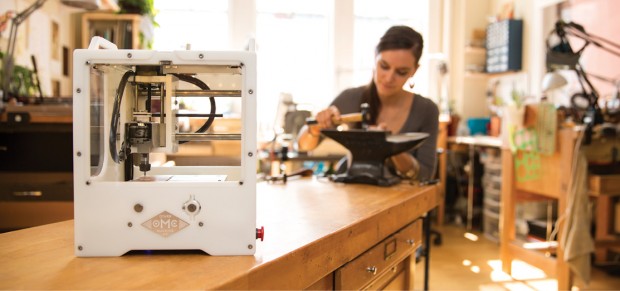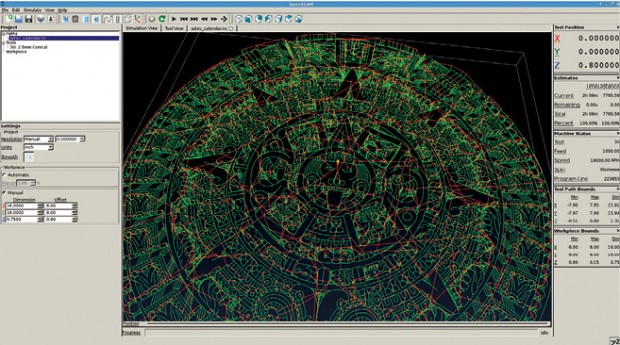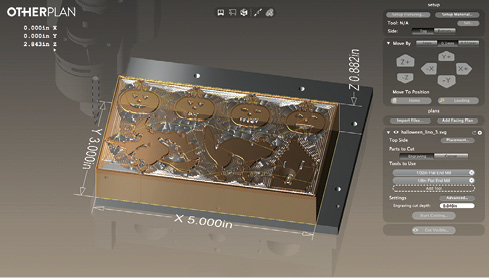Ease of Use is the New Mission in CAM

With the $2,199 Othermill, Other Machine Co. (OMC) hopes to attract people unfamiliar with traditional manufacturing or machining. Image courtesy of Other Machine Co.
Latest News
April 1, 2015
 With the $2,199 Othermill, Other Machine Co. (OMC) hopes to attract people unfamiliar with traditional manufacturing or machining. Image courtesy of Other Machine Co.
With the $2,199 Othermill, Other Machine Co. (OMC) hopes to attract people unfamiliar with traditional manufacturing or machining. Image courtesy of Other Machine Co.The sun was streaming into the Herbst Pavilion at San Francisco Fort Mason, the site of Autodesk REAL 2015 Conference (February 25-26). Ezra J. Spier and his colleagues from Other Machine Co. (OMC) set up their booth by a window looking out to the Golden Gate Bridge. The machine on display was a portable desktop CNC (computer numerically controlled) machine, roughly the size of a beer cooler. It’s called the Othermill, priced at $2,199.
Holding an exquisite piece of wood with mother of pearl inlay, Spier explained, “Our machine works with wax, plastic, rubber, wood, aluminum, brass, copper — anything softer than steel,” says Spier, OMC wants to bring CNC to people who don’t have training in manufacturing or machining. “To make that happen, we built our own software,” he says. In line with the company’s brand, the software is dubbed Otherplan.
Joseph Coffland is someone else who hopes to bring CAM to a new community. By his own admission, Coffland had little to no experience with commercial CAM programs. He felt that made him the ideal person to develop a program for the underserved segment frustrated with over-complicated software packages. He’s going after the makers, hobbyists, tinkerers and DIYers — the uninitiated who are just like him.
Coffland came up with OpenSCAM, which stands for Open-Source Simulation and CAM. The name was originally an off-the-cuff joke to the hacker community; but now that it has become a more serious piece of software, he plans to change it. In the process of developing his 3-axis CNC program, he also learned a lot about the commercial CAM titles available in the market.
These new players’ outreach efforts are indicative of the coming of a different breed of CAM software, characterized by a simpler interface and a smaller set of functions. Established CAM vendors who target a different market feel the pressure to make CAM easier, more accessible and more affordable.
Milling for the Other People
OMC manufactures its milling machine domestically in the U.S. It’s headquartered in San Francisco’s Mission District, a café-dotted hub for tech workers. 3D printing may be hip, but OMC’s Spier points out CNC has certain advantages. One is the ability to cut into materials that come from life, like wood and mother of pearl.
OMC’s software Otherplan is currently available only for Mac OS. “Historically, there have been very few options for CAD/CAM/CNC on the Mac, but in the design world it’s the dominant platform. With Otherplan on Mac OS, we’ve been able to quickly bring CNC to an entirely new group of people,” says Spier.
Traditional CNC focuses on producing complex mechanical shapes, but Spier believes robust 2D pattern cutting is important, especially in prototyping printed circuit boards (PCBs). He said, “With our software, it’s very easy to do 2D cuts or build PCBs. Typically, you need to do complicated things to get your toolpaths for PCB. With our software, all you have to do is load your design file,” he says.
Spier doesn’t see a distinction between professional and maker markets. OMC wants to cater to both. The more important trend to note is the changing definition of manufacturing itself. “We see the future of manufacturing not as bigger factories but as smaller ones and neighborhood operations. So we want to build a machine that cuts with factory-level precision, but runs on a much smaller scale,” he says.
Open-Source CAM
Coffland may be new to CAM, but not to software development. He operates Cauldron Development LLC, a software engineering business.
“I’m not trying to compete with the existing CAM packages,” he says. “My software focuses more on accomplishing basic tasks, without burdening it with the advanced features experts might want.” For example, cutting text into solids — one of the often-requested functions among the maker community — is often not supported or is overly complicated in professional CAM programs.
Coffland acknowledges the current open-source CAM software choices — including his — cannot compete with commercial packages when it comes to supporting the needs of traditional manufacturers. “Most commercial operations are running on commercial software,” he said. “But it’s not out of the question. The key is figuring out a way to fund the open-source movement. It takes a lot of time and effort to develop quality software. That takes money.”
Precedence of open-source solutions supporting commercial enterprises may be rare in CAD and CAM, but it exists in other areas of manufacturing. For example, Aras, an open-source product lifecycle management (PLM) program, competes on equal footings with other paid solutions.
“Commercial vendors tend to offer a dumbed down version to beginners, in the hope that they can ask you to pay more for the professional version. That tends to turn off the makers,” Coffland says. He hopes his OpenSCAM will mature over time through user input and labor, giving the community a sense of ownership and loyalty.
“In the last 12 months, I have seen about 15,000 downloads of OpenSCAM, mostly from the U.S., but spread out across the world,” Coffland says. “Our web traffic is about 500 unique visits a day, and that’s with little or no advertising or marketing efforts.”
Coffland is gearing up for the next phase of the software, to be accompanied by an awareness-building campaign. Blender CAM, another open-source CAM program, targets artistic users, focusing more on cutting patterns and shapes favored by illustrators, jewelry designers and toy makers.
CAM with the Look and Feel of CAD
Commercial vendors like Autodesk are eying the maker movement with interest. In 2011, the design software titan acquired Instructables, a popular destination for DIY-ers to learn how to do everything, from making cupcakes to building aerial drones. Autodesk offers Inventor HSM Express, a 2.5-axis milling and drilling program, for free. Even if it’s not originally targeted at consumers or prosumers, such free and low-cost offers from well-funded commercial vendors represent stiff competition for Open-Source CAM, still in its nascent stage.
 Preview of the toolpath for an Aztec calendar, shown in open-source CAM program OpenSCAM. Image courtesy of OpenSCAM
Preview of the toolpath for an Aztec calendar, shown in open-source CAM program OpenSCAM. Image courtesy of OpenSCAMFor Autodesk, the key to ease of use rests with a CAM environment that’s virtually indistinguishable from the CAD program. “The first step is to make the CAM system looks, acts, and feels like what the designers are used to,” says Al Whatmough, product line manager for Autodesk CAM.
Autodesk’s CAM product line came via its acquisition of HSMWorks, a company with a well-known plug-in for SolidWorks users. After the purchase, Autodesk added Inventor HSM for Autodesk Inventor users. Both SolidWorks and Inventor users have the option to test the waters first with free versions of HSMXpress for SolidWorks and Inventor HSM Express.
Freeware is often associated with low-quality of buggy versions, but “[Autodesk] actually waited until our software was robust enough before we started giving it away. If users are frustrated with our free product, they would never look at our paid version,” says Whatmough.
The tightest integration between CAD and CAM came in the form of Autodesk Inventor Fusion 360, a CAD-CAM combo that includes cloud-hosted project management and collaboration tools. The move to integrate cloud-hosted features and a subscription-based model — both part of Autodesk’s long-term strategy — are calculated to make installing, managing and using the software easier.
“Shops that make and produce their own designs love [the cloud-hosted features], but when they’re producing someone else’s design, they might hesitate a bit, because they can’t make that decision [to trust the cloud] for their client,” says Whatmough.
But Whatmough gets a chuckle when the same people who express concerns for cloud security don’t have any qualms about emailing him design files — a less secure form of file transfer, in his assessment.
Balancing Automation, Ease of Use and Power
Can you simplify CAM enough for a beginner without reducing the software’s capacity? That’s a question that CAM software vendors have wrestled with for years, but the emergence of 3D printing increases the pressure. With 3D printing, the STL file exported from the CAD program can go directly to a printer. Sometimes the file requires cleanup or fixes, but the skills required for this step is minimal. Often printing service bureaus are happy to offer such services for a nominal fee or consider it part of the printing job’s cost. A CAM package typically demands some time and effort in training to be proficient.
“We have templates that let you pick a machining strategy and apply it to your model, so we let you go quickly from digital art to physical part in CAM,” says Whatmough. “But the value that individual machine shops offer is their expertise in refining the program for efficiency.”
The balancing job for CAM vendors is to offer automated toolpath verification and machining functions for beginners while leaving enough room for skilled programmers to customize the jobs for best speed and output.
“Otherplan has a variety of features to help ensure that your geometry is milled in the way you want. For example, if you load a file that will cut into hardware you have installed on the mill, or if your geometry is too big for your material, you’ll see a warning. Otherplan also gives you a full toolpath preview, which shows you the areas that will, or will not cut, given the tools you’ve selected,” OMC’s Spier says.
 Otherplan, the CAM software from Other Machine Co., shows a toolpath preview for an intricate Halloween stamp. Image courtesy of Other Machine Co.
Otherplan, the CAM software from Other Machine Co., shows a toolpath preview for an intricate Halloween stamp. Image courtesy of Other Machine Co.“Our software has lots of complexity and nuances to allow you to do pretty much anything you want, but because of that it may be overwhelming for beginners. We’re looking at simplifying the user interface,” says Greg Olsen, president of SmartCAM.
Olsen envisions the emergence of on-demand CAM, delivered from the cloud. “The idea is to let people pay for it in smaller amount, like a day’s worth or a week’s worth of CAM in the cloud,” he says. Such a licensing model, he pointed out, would be attractive to businesses that must deal with complex surfaces for, say, three or four times a year, but not in all projects.
For CAM software developers primarily targeting the consumers and maker market, the balancing act is easier. A majority of the projects in this space doesn’t require complicated machining strategies. With most users attempting to cut 2D patterns onto plates, pendants and personalized objects, the software proves easier to automate and simplify. The job is more challenging for CAM vendors attempting to cater to both power users and newcomers.
Subscribe to our FREE magazine, FREE email newsletters or both!
Latest News
About the Author
Kenneth Wong is Digital Engineering’s resident blogger and senior editor. Email him at [email protected] or share your thoughts on this article at digitaleng.news/facebook.
Follow DE





